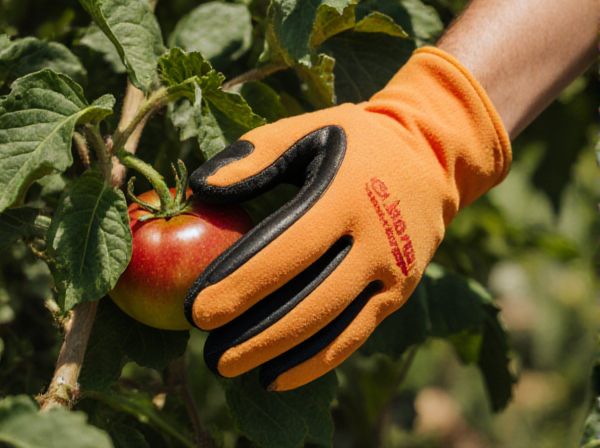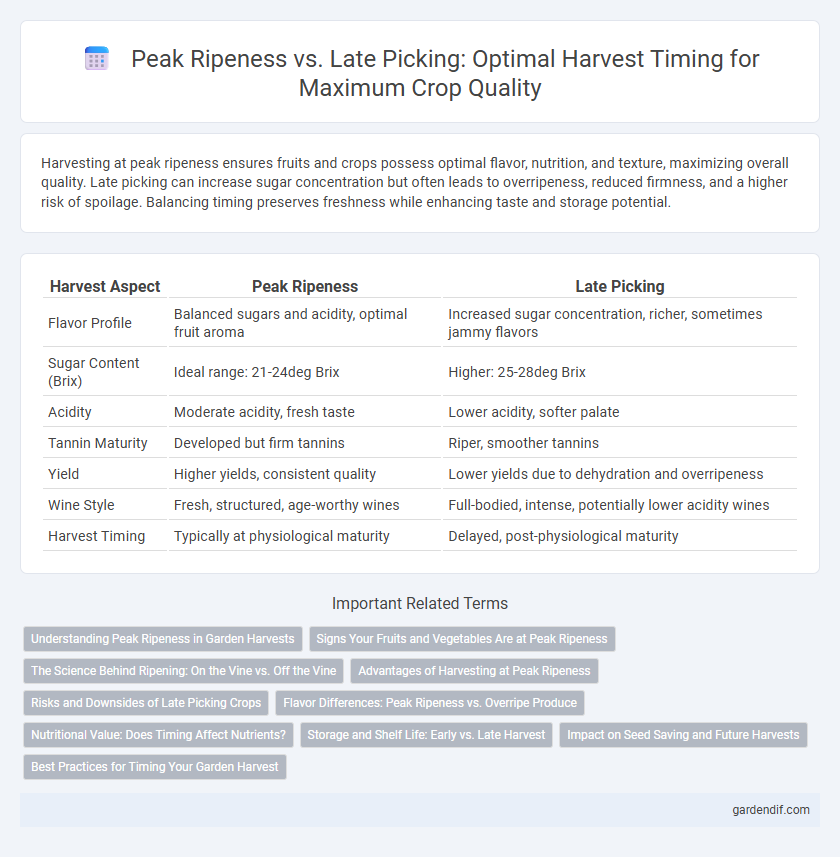
Peak ripeness vs Late picking Illustration
Harvesting at peak ripeness ensures fruits and crops possess optimal flavor, nutrition, and texture, maximizing overall quality. Late picking can increase sugar concentration but often leads to overripeness, reduced firmness, and a higher risk of spoilage. Balancing timing preserves freshness while enhancing taste and storage potential.
Table of Comparison
| Harvest Aspect | Peak Ripeness | Late Picking |
|---|---|---|
| Flavor Profile | Balanced sugars and acidity, optimal fruit aroma | Increased sugar concentration, richer, sometimes jammy flavors |
| Sugar Content (Brix) | Ideal range: 21-24deg Brix | Higher: 25-28deg Brix |
| Acidity | Moderate acidity, fresh taste | Lower acidity, softer palate |
| Tannin Maturity | Developed but firm tannins | Riper, smoother tannins |
| Yield | Higher yields, consistent quality | Lower yields due to dehydration and overripeness |
| Wine Style | Fresh, structured, age-worthy wines | Full-bodied, intense, potentially lower acidity wines |
| Harvest Timing | Typically at physiological maturity | Delayed, post-physiological maturity |
Understanding Peak Ripeness in Garden Harvests
Harvesting at peak ripeness ensures optimal flavor, nutrient content, and shelf life for garden crops, maximizing the quality of fruits and vegetables. Late picking often leads to overripeness, resulting in reduced taste, increased susceptibility to pests, and diminished nutritional value. Understanding indicators such as color, firmness, and aroma helps gardeners determine the ideal harvest time to achieve the best yield and freshness.
Signs Your Fruits and Vegetables Are at Peak Ripeness
Fruits and vegetables show vibrant colors, firm yet slightly soft textures, and fragrant aromas as clear signs of peak ripeness, ensuring optimal flavor and nutritional value. Leaves and stems often remain green and fresh, while fruits yield slightly under gentle pressure without being mushy. Overripe produce displays dull skin, excessive softness, and may emit sour scents, indicating late picking and potential quality degradation.
The Science Behind Ripening: On the Vine vs. Off the Vine
Peak ripeness is achieved when fruit reaches optimal sugar content, acidity balance, and flavor complexity directly on the vine, maximizing enzymatic activity and nutrient absorption. Late picking, or harvesting after peak ripeness, often results in decreased quality due to overripening, loss of firmness, and diminished aromatic compounds affected by continued respiration off the vine. Understanding the biochemical processes during on-vine maturation versus off-vine ripening is crucial for determining harvest timing to ensure the best sensory and nutritional profiles.
Advantages of Harvesting at Peak Ripeness
Harvesting at peak ripeness maximizes sugar content and flavor complexity, resulting in superior quality produce or wine. Optimal nutrient levels improve fruit firmness and reduce susceptibility to disease, enhancing shelf life and consumer satisfaction. Early picking preserves acidity balance, crucial for fresh taste and optimal fermentation in winemaking processes.
Risks and Downsides of Late Picking Crops
Picking crops past peak ripeness increases the risk of fruit overripening, leading to reduced firmness and lower market value. Late picking can also expose produce to pest infestations, mold growth, and adverse weather conditions that degrade quality and yield. These factors contribute to economic losses and decreased storage potential for harvested crops.
Flavor Differences: Peak Ripeness vs. Overripe Produce
Harvesting crops at peak ripeness ensures optimal flavor profiles, characterized by balanced sugars, acidity, and aromatic compounds that enhance taste complexity. Overripe produce, often resulting from late picking, tends to develop excessive sugars and diminished acidity, leading to overly sweet or fermented flavors that can mask natural freshness. Flavor differences between peak-ripe and overripe fruits and vegetables significantly impact culinary applications, with peak ripeness preferred for vibrant, nuanced dishes while late-picked items suit recipes benefiting from intensified sweetness.
Nutritional Value: Does Timing Affect Nutrients?
Peak ripeness maximizes nutrient content, with fruits and vegetables exhibiting higher levels of vitamins, antioxidants, and essential minerals compared to late picking. Delayed harvest often results in nutrient degradation due to prolonged exposure to environmental factors and metabolic changes within the produce. Scientific studies confirm that optimal harvest timing preserves phytochemicals, enhancing both nutritional value and health benefits.
Storage and Shelf Life: Early vs. Late Harvest
Harvesting at peak ripeness ensures optimal storage quality and extends shelf life due to balanced sugar and acid levels, which slow down spoilage processes. Late picking can result in overripe produce with higher sugar content, accelerating microbial growth and reducing storage duration. Selecting harvest time based on desired shelf life is critical for maintaining freshness and minimizing post-harvest losses.
Impact on Seed Saving and Future Harvests
Harvesting at peak ripeness maximizes seed viability and genetic vigor, ensuring robust future crops with high germination rates. Late picking often leads to seed degradation, reducing germination potential and increasing susceptibility to diseases, which undermines seed saving efforts. Timely harvesting preserves essential seed quality traits and supports sustainable, productive harvest cycles.
Best Practices for Timing Your Garden Harvest
Harvesting your garden at peak ripeness ensures optimal flavor, nutritional value, and texture in fruits and vegetables, while late picking often results in overripe produce with diminished quality. Key indicators for peak ripeness include color changes, firmness, and days since flowering, tailored to each crop's specific growth cycle. Implementing consistent observation and timely harvesting techniques maximizes yield and extends storage life, promoting both garden productivity and food quality.
Peak ripeness vs Late picking Infographic

 gardendif.com
gardendif.com